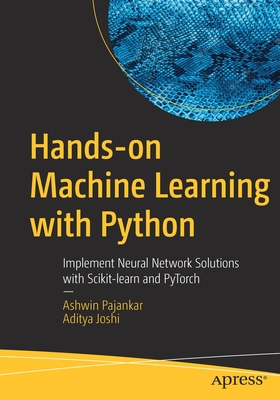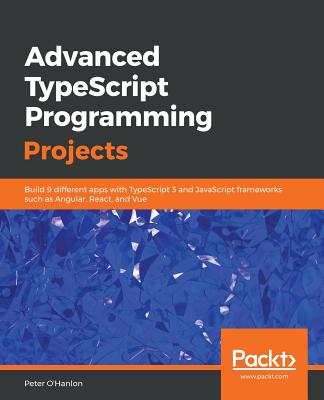Hands-On Machine Learning with scikit-learn and Scientific Python Toolkits: A practical guide to implementing supervised and unsupervised machine lear
暫譯: 實作機器學習:使用 scikit-learn 和科學 Python 工具包的實用指南
Amr, Tarek
- 出版商: Packt Publishing
- 出版日期: 2020-07-24
- 售價: $1,840
- 貴賓價: 9.5 折 $1,748
- 語言: 英文
- 頁數: 384
- 裝訂: Quality Paper - also called trade paper
- ISBN: 1838826041
- ISBN-13: 9781838826048
-
相關分類:
Python、程式語言、Machine Learning
海外代購書籍(需單獨結帳)
買這商品的人也買了...
-
 機器人 SLAM 導航:核心技術與實戰
機器人 SLAM 導航:核心技術與實戰$894$849 -
 視覺慣性 SLAM:理論與源碼解析
視覺慣性 SLAM:理論與源碼解析$806$758 -
 多模態大模型:技術原理與實戰
多模態大模型:技術原理與實戰$600$570
商品描述
Integrate scikit-learn with various tools such as NumPy, pandas, imbalanced-learn, and scikit-surprise and use it to solve real-world machine learning problems
Key Features
- Delve into machine learning with this comprehensive guide to scikit-learn and scientific Python
- Master the art of data-driven problem-solving with hands-on examples
- Foster your theoretical and practical knowledge of supervised and unsupervised machine learning algorithms
Book Description
Machine learning is applied everywhere, from business to research and academia, while scikit-learn is a versatile library that is popular among machine learning practitioners. This book serves as a practical guide for anyone looking to provide hands-on machine learning solutions with scikit-learn and Python toolkits.
The book begins with an explanation of machine learning concepts and fundamentals, and strikes a balance between theoretical concepts and their applications. Each chapter covers a different set of algorithms, and shows you how to use them to solve real-life problems. You'll also learn about various key supervised and unsupervised machine learning algorithms using practical examples. Whether it is an instance-based learning algorithm, Bayesian estimation, a deep neural network, a tree-based ensemble, or a recommendation system, you'll gain a thorough understanding of its theory and learn when to apply it. As you advance, you'll learn how to deal with unlabeled data and when to use different clustering and anomaly detection algorithms.
By the end of this machine learning book, you'll have learned how to take a data-driven approach to provide end-to-end machine learning solutions. You'll also have discovered how to formulate the problem at hand, prepare required data, and evaluate and deploy models in production.
What you will learn
- Understand when to use supervised, unsupervised, or reinforcement learning algorithms
- Find out how to collect and prepare your data for machine learning tasks
- Tackle imbalanced data and optimize your algorithm for a bias or variance tradeoff
- Apply supervised and unsupervised algorithms to overcome various machine learning challenges
- Employ best practices for tuning your algorithm's hyper parameters
- Discover how to use neural networks for classification and regression
- Build, evaluate, and deploy your machine learning solutions to production
Who this book is for
This book is for data scientists, machine learning practitioners, and anyone who wants to learn how machine learning algorithms work and to build different machine learning models using the Python ecosystem. The book will help you take your knowledge of machine learning to the next level by grasping its ins and outs and tailoring it to your needs. Working knowledge of Python and a basic understanding of underlying mathematical and statistical concepts is required.
商品描述(中文翻譯)
將 scikit-learn 與 NumPy、pandas、imbalanced-learn 和 scikit-surprise 等各種工具整合,並用於解決現實世界的機器學習問題
主要特點
- 透過這本全面的 scikit-learn 和科學 Python 指南深入了解機器學習
- 通過實作範例掌握數據驅動的問題解決藝術
- 增進對監督式和非監督式機器學習演算法的理論和實務知識
書籍描述
機器學習應用無所不在,從商業到研究和學術界,而 scikit-learn 是一個在機器學習從業者中廣受歡迎的多功能庫。本書作為一本實用指南,適合任何希望使用 scikit-learn 和 Python 工具包提供實作機器學習解決方案的人。
本書首先解釋機器學習的概念和基本原理,並在理論概念與其應用之間取得平衡。每一章涵蓋不同的演算法,並展示如何使用它們來解決現實生活中的問題。您還將學習各種關鍵的監督式和非監督式機器學習演算法,並通過實作範例進行學習。無論是基於實例的學習演算法、貝葉斯估計、深度神經網絡、基於樹的集成,還是推薦系統,您都將深入了解其理論並學會何時應用它。隨著進步,您將學會如何處理未標記數據,以及何時使用不同的聚類和異常檢測演算法。
在這本機器學習書籍結束時,您將學會如何採用數據驅動的方法提供端到端的機器學習解決方案。您還將發現如何制定當前問題、準備所需數據,以及在生產環境中評估和部署模型。
您將學到什麼
- 了解何時使用監督式、非監督式或強化學習演算法
- 了解如何收集和準備數據以進行機器學習任務
- 處理不平衡數據並優化演算法以達成偏差或變異的權衡
- 應用監督式和非監督式演算法來克服各種機器學習挑戰
- 採用最佳實踐來調整演算法的超參數
- 發現如何使用神經網絡進行分類和回歸
- 構建、評估並將您的機器學習解決方案部署到生產環境
本書適合誰
本書適合數據科學家、機器學習從業者以及任何希望了解機器學習演算法如何運作並使用 Python 生態系統構建不同機器學習模型的人。本書將幫助您提升對機器學習的知識,深入了解其內部運作並根據您的需求進行調整。需要具備 Python 的工作知識以及對基本數學和統計概念的基本理解。










